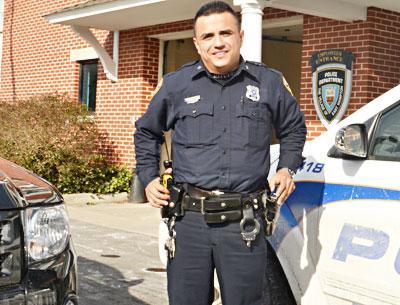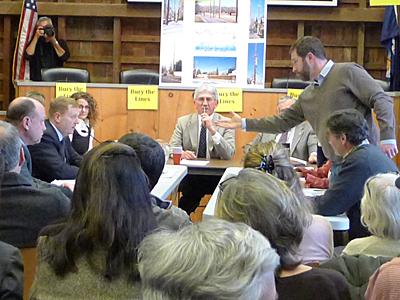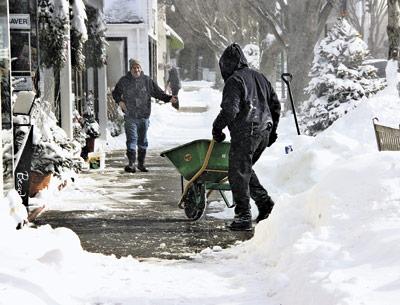Fired by Fire District
Fired by Fire District

After several contentious months, the embattled treasurer of the Bridgehampton Fire District has filed a $40 million suit in federal court against the district, its commissioners, and the former chairman of the board.
Charles E. Butler Jr. claims that the five-member board of fire commissioners acted in retaliation when it removed him from his post as the appointed district secretary late last year and then cut his salary as the elected treasurer in the new year. In the suit, he claims that board members, including Steven Halsey, a former chairman who was not re-elected in December, were angry at him for speaking out against the way in which the board was going about selling a small but valuable property it owned at 113 Main Street in Wainscott.
In January, the commissioners accused Mr. Butler, who has worked for the district for nearly 30 years, of committing a felony, saying he had forged the fire chief’s signature on a letter to the state Civil Service Department, division of employee benefits, stipulating that his house had burned down in a 2012 fire. That allegation was among others handed over to the Suffolk County District Attorney’s government corruption bureau; the status of that investigation is not clear. Since Jan. 1, Mr. Butler is no longer the district’s secretary. His $30,000 salary as treasurer has been slashed, and he has been stripped of several duties.
He believes he was targeted by the district after he spoke out, as a resident, at a 2013 meeting during which, he said, the board tried to award the vacant Wainscott parcel without adhering to a formal bidding process. The 6,000-square-foot property was eventually sold for $940,000 to the billionaire Ronald Lauder, who owns 115 Main Street, directly to its west. The suit alleges that the sale was $60,000 to $70,000 lower than other offers made to the fire district.
The property was appraised at $1.1 million in July 2011, according to paperwork provided by the district.
Mr. Butler claims in the suit that he was advised by Tom Preiato, chief building inspector of East Hampton Town, that the property could hold a 2,100-square-foot house, three times the 700 square feet displayed on the survey as the potential size. He claims Mr. Halsey told him not to share that information with anyone. Mr. Halsey later told news reporters, he asserts, that the property could only accommodate a smaller house.
“Steven Halsey breached his fiduciary duty to the taxpayers of the fire district in not correcting the press’s use of the 700-square-feet restriction on the size of a private residence,” the suit claims.
It goes on to assert that when the bids were opened, a competing bid was not opened, and that only Mr. Lauder’s was, and goes on to claim that Mr. Halsey, a real estate agent with Douglas Elliman who was once former New York State Gov. George Pataki’s Long Island representative, may have had a previous relationship with Mr. Lauder. Mr. Lauder, a prominent Republican, was a friend of Mr. Pataki’s and a major contributor to his campaigns, and Mr. Lauder reportedly paid Mr. Pataki's wife as a consultant while the governor was in office.
In a referendum on Dec. 10, Bridgehampton voters approved the sale of the property, says the lawsuit, “without any disclosure of Steven Halsey’s and the Bridgehampton Board of Fire Commissioners’ illegal agreement to sell the vacant parcel to Ronald Lauder in the face of superior offers by others interested in the parcel.”
Mr. Butler, who owns property in Wainscott, objected that the proper bidding process was not being followed, though John Courtney, then the district’s lawyer, had advised the district commissioners of the “proper procedure” for the property to be advertised and sealed bids to be accepted. “They retaliated against him for that free speech,” said Thomas Horn, a Sag Harbor attorney who, with Lawrence Kelley, is representing Mr. Butler.
Mr. Butler’s attorneys said it was against New York State and Suffolk County law for an elected official’s salary to be cut in the midst of a term. Their client’s position as treasurer does not expire until Dec. 31, 2014. The lawyers also believe his First Amendment rights were violated.
“It’s just such a far-fetched allegation. We are shocked he is making it,” said Brad Pinsky, the fire district’s attorney since the fall. Mr. Pinsky claimed Mr. Butler was never fired from his secretary position, but rather that his year-to-year appointment was not renewed at the end of 2013, at a savings of $30,000 to the district.
“He had not shown up from September or October,” Mr. Pinsky said, adding that the board acted on a recommendation he made after compiling 18 pages worth of concerns about Mr. Butler’s job performance. As an example, he cited the district’s being fined $1,800 recently by Social Security, for failure to file tax-related documents last year.
Mr. Butler’s treasurer’s salary was cut because “he has not been showing up to fulfill any of his duties for months,” Mr. Pinsky said. The lawyer also does not believe the state and county laws about cutting an elected official’s salary during a term of office apply to fire districts.
Mr. Pinsky said he likely would not represent the district in the lawsuit because he expects to be called as a defense witness. He had not yet seen the suit, he said yesterday. Though news of it was made public last week, it was only filed in Central Islip on Tuesday morning.
Toward the end of 2013, the board fire commissioners parted ways with Mr. Courtney and hired Mr. Pinsky, a Syracuse attorney specializing in fire district law. That was about the same time that the board began excluding Mr. Butler from executive sessions, and soon the decision was made to eliminate the salary for secretary and reduce the treasurer’s salary, for a total savings of about $80,000. Mr. Butler was notified in an October 2013 letter that he was no longer allowed to take official minutes. Mr. Pinsky indicated yesterday, however, that he was still expected to show up.
The board asked district voters, in the Dec. 10 referendum and fire district election, to change the treasurer’s job from elected to appointed, which Mr. Butler also claims was retaliatory. That proposal failed to pass.
Two weeks before the referendum, the board had used public money to take out a full-page advertisement in The Southampton Press, calling it “an open letter” to district residents and fire department members “to set the record straight before too many people start believing the lies that are being spread around our community.” Mr. Butler’s attorneys believe the “letter” was more of a political campaign ad, which is prohibited under New York State Public Officers Law, and say it was put in to benefit Mr. Halsey, who was up for re-election. It cost between $2,625 and $3,831.
Mr. Halsey declined comment.







